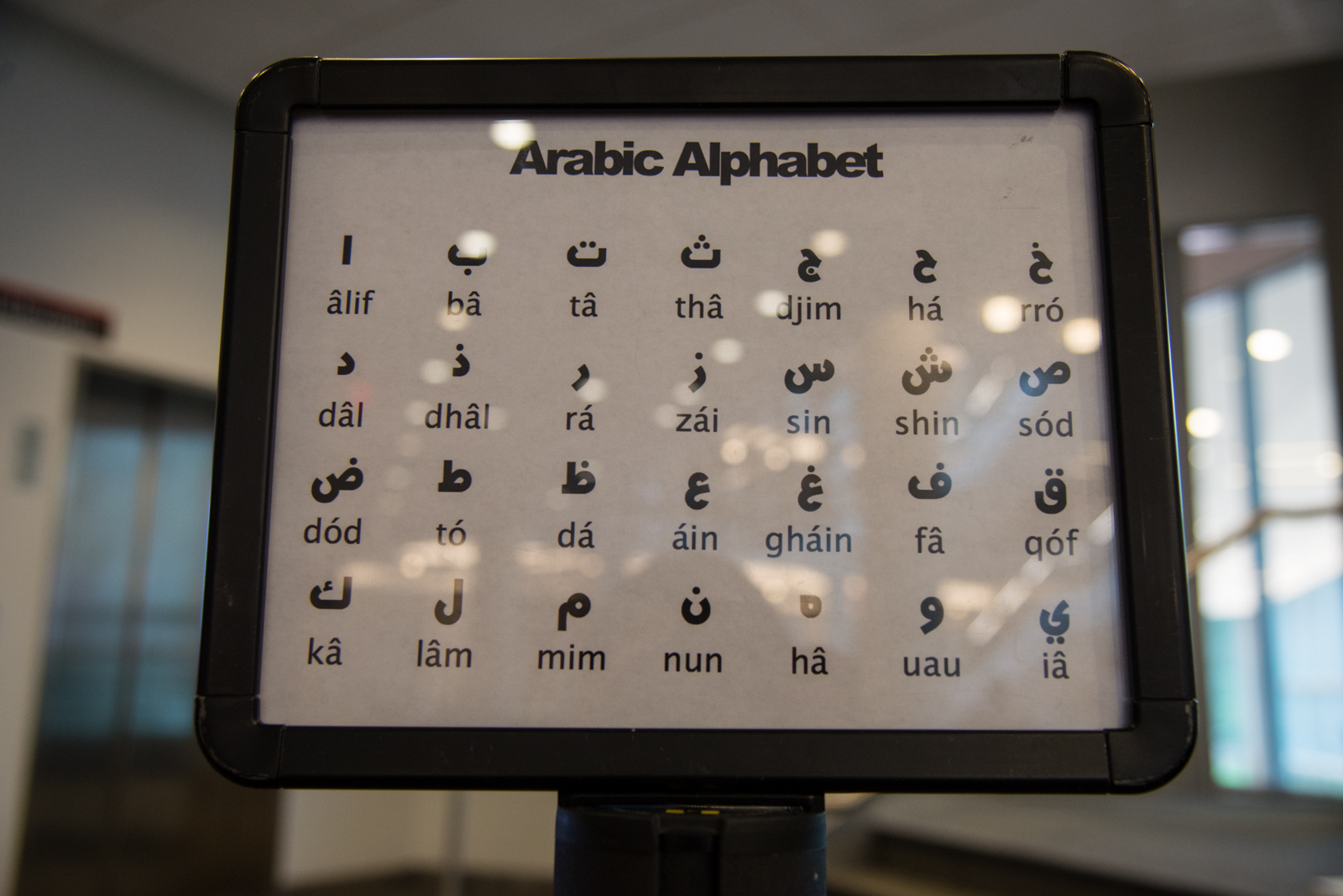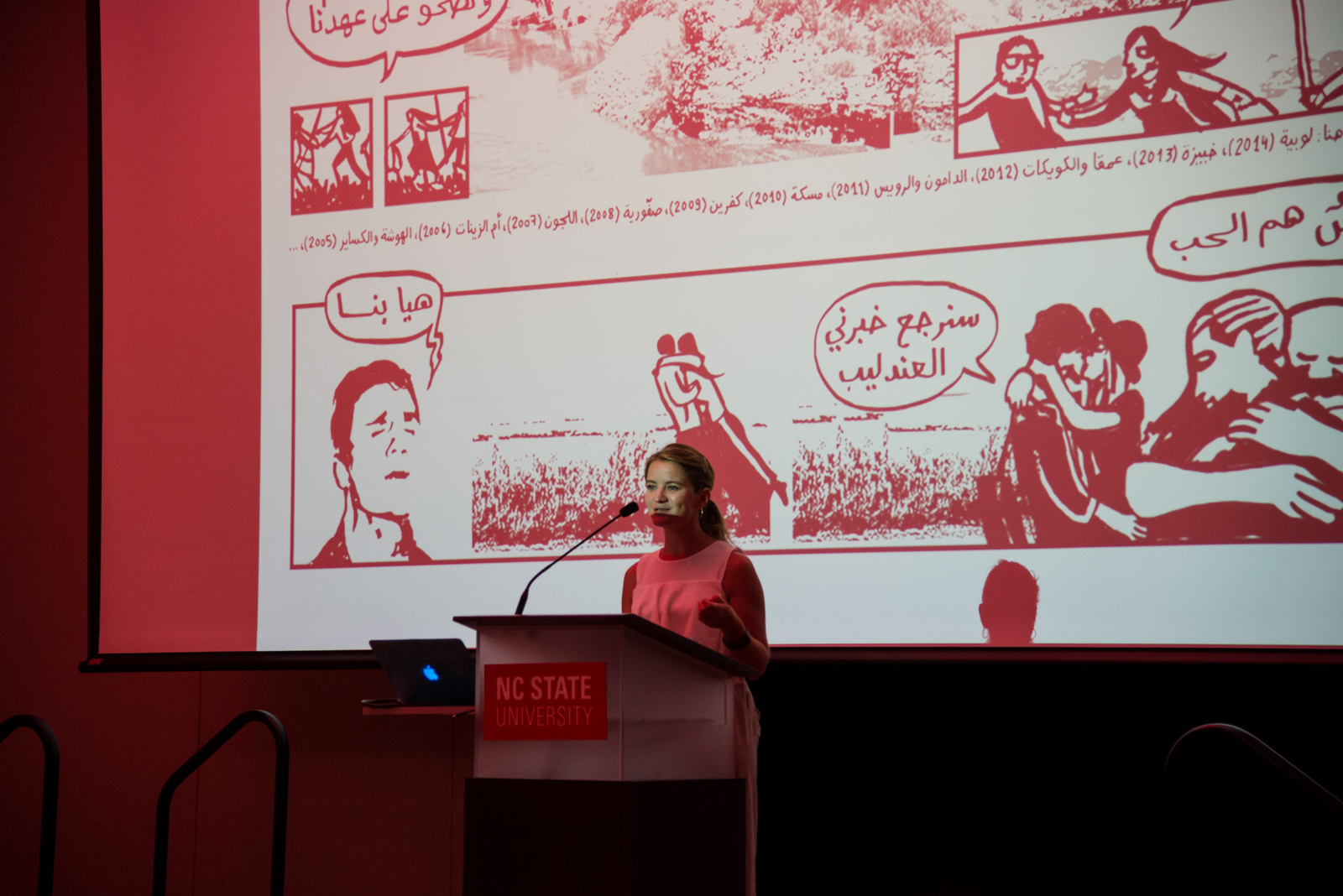Dr. Lena Merhej: Visual storyteller living in two worlds
This post is written by Raja Abillama. He teaches anthropology and international studies at North Carolina State University. His research is focused on transnational secularism and the government of religion in Lebanon. Abillama is working on a series for the Center about Lebanese adoptive diaspora. You can read the first of three installments here.
North Carolina State University had the pleasure of hosting Dr. Lena Merhej as artist-in-residence between September 24 and October 1, 2016. Dr. Merhej was invited by the Khayrallah Center for Lebanese Diaspora Studies, in collaboration with Arts NC State. Her week-long visit included talks, class visits, panel discussions, and student workshops, all culminating in an exhibition of her and the students’ work. The hub of all this activity was the second floor of the Talley Student Center with its free plan and wonderfully lit atrium. Talley provided the exposure, lighting, and flexibility needed for the integration of the various parts of her visit into a single, focused event.
Dr. Merhej describes herself as “a visual storyteller and an expert in graphic narration.” She is the author of a number of works: an animation entitled Drawing the War (2002), a comic book, سنة كمان (Another year, 2009), and an illustrated autobiographical book, ولبن مربى (Yogurt and Jam, 2011), all three having received international awards. She taught at the American University of Beirut and the Lebanese American University, and currently teaches at the Lebanese International University. She is the founder and director of the Story Center, which offers professional training in animation, illustration and comic books, and the director of the Beirut Animated festival. She is also co-founder and editor-in-chief of the trilingual comics magazine Samandal (Salamander.) “Much like the dual habitats of amphibious creatures,” Dr. Merhej explains, “Samandal comics thrive between two worlds: the image and the word, entertainment and substance, the low- and high-brow, the experimental and the traditional.” Samandal is not just an artifact, however, but a testimony to the collective’s commitment to comic art—to art in general—and its potential culturally, socially, ethically and politically. It is an entirely “volunteer-based non-profit organization dedicated to the advancement of the art of comics in Lebanon and the rest of the world.” Based in Beirut, Samandal has published fifteen magazines and two comic anthologies and hosted comics-related events since 2007. Some of their magazines and anthologies were on display at the exhibition at Talley.
Dr. Merhej told the story of her adventures with comics and graphic art on the evening of the 29th in a Piedmont Ballroom packed with captivated students, faculty, and members of Raleigh’s diasporic community. Her talk was a complex narrative, unfurling over an hour and a half, of the interpenetration of the personal and professional, movement and stillness, word and image. Indeed, with the gigantic screen behind her, before which she stood casting her shadow on it alongside the continuous flicker of images of her own drawings and illustrations, her talk was more of a performance or, better yet, a three-dimensional comic strip or animation in which everyone present was drawn in with a role to play. Dr. Merhej took her audience with her on a journey that started during her years as a graphic design student interested in animation, continued through her work with the Samandal collective and the various workshops she conducted, and ending—provisionally!—with her more recent visual and scholarly work.
Dr. Merhej’s scope is very diverse, encompassing a variety of forms and techniques—the still image, comic strip, animation, typography, and illustration—through which she seeks to evoke an equally diverse range of moods and feelings. It was in this vein that she delivered her talk, guiding the audience through a body of work that is moving, humorous, intimate, sometimes tragic, but consistently interesting and provocative. Inevitably in contemporary Lebanon and the Middle East, her work is also public, provocative, and challenging, touching upon such themes as the Lebanese Civil War of 1975-1990, the Palestinian struggle, the Arab uprisings and their aftermath, Syrian refugees, gender, sexuality, and violence.
Students had the unique opportunity to create their own illustrations with Dr. Merhej in two consecutive two-hour-long workshops. These were held in the lounge-life area adjacent to the offices of Arts NC State, benefiting from the latter’s abundant supply of material and immaterial support, and the former’s overlooking view of the dining commons. The workshops had the objective of creating visual commemorations of the event, which all of the participants brilliantly accomplished by dazzling combinations of Arabic letters with corresponding references to the State of North Carolina. The result was a dozen or so of colorful, well-crafted illustrations that stood alongside Dr. Merhej’s own work at the exhibition the following day. Occupying the spaces between the large columns that ran parallel to one side of the atrium, the array of illustrations, prints, books, and other drawings could be seen from almost any point on the stairwells and slabs surrounding Talley’s luminous void.
Students had another opportunity to meet and talk with Dr. Merhej in a couple of class visits. Dr. Golbarg Rekabtalaei and her HI 270 Modern Middle East class were among the fortunate ones to “share [Dr. Merhej’s] work on the representation of war in graphic novels in Lebanon …” She and her students found “the topic … fascinating” and were happy to learn “that graphic novels were so popular in contemporary Lebanon,” a fact that was not well-known. Dr. Merhej’s visit “added a valuable cultural component to our study of the Civil War, and allowed students to contextualize events in Lebanon before and after the war.” Her visit received “positive feedback” on the part of Dr. Rekabtalaei’s students, who “ask[ed] for more speakers to come to our class and talk about the cultural history of the Middle East.” Clearly, the event was an immense benefit to all. Mr. Rich Holly, Executive Director of Arts NC State, concurs, “Lena’s time on campus exceeded all expectations. Her ability to connect with students was exemplary and her remarks on the issues of censorship and banning were thoughtful and insightful.”
All thanks go to: Prof. Akram Khater, Director, Khayrallah Center for Lebanese Diaspora Studies; Mr. Rich Holly, Executive Director at Arts NC State; Ms.Amy Sawyers, Outreach Programmer and Instructor of Arts Village AV 100 at Arts NC State; Dr. Shea McManus, Assistant Professor of Anthropology and International Studies; Dr. Raja Abillama, Lecturer, Cultural Anthropology and International Studies; Dr. Golbarg Rekabtalaei, PostDr.al Teaching Scholar, Department of History; Ms. Kristen Porter, Program Associate (and Photographer) at Khayrallah Center for Lebanese Diaspora Studies; all the students who participated to make this event possible.
- Categories:






